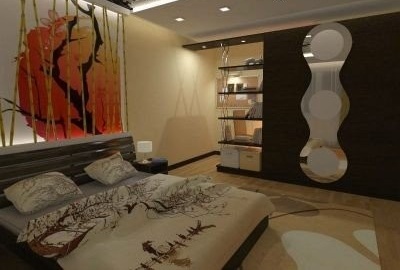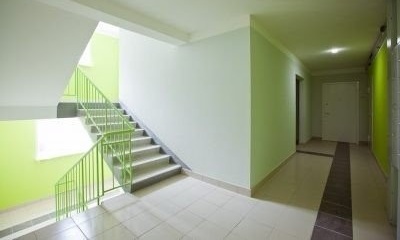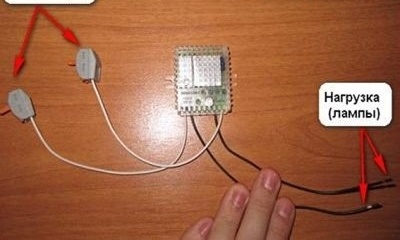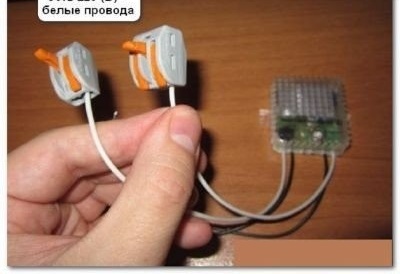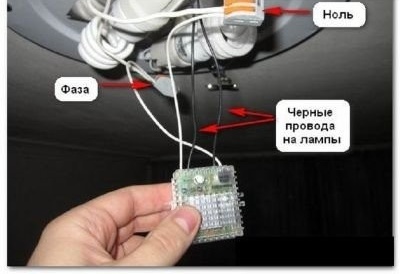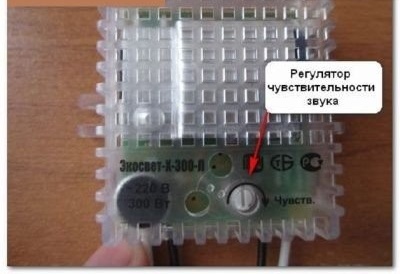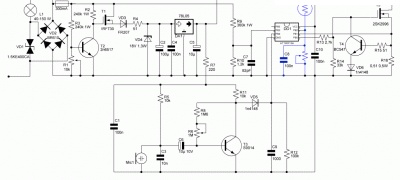Turning the light on and off: popping the appliance yourself
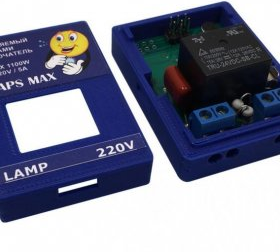
An acoustic (or cotton) switch is an electronic device that is convenient to use in everyday life. It is a device for remote control of light sources. You can turn on and off the lighting by clapping your hands by transmitting an acoustic signal to the acoustic device. Such equipment has some features, but it is possible to assemble it yourself.
Content
Cotton switch application
An acoustic (or cotton) switch is designed to control electricity in various rooms remotely, that is, without touching the toggle switch directly. This device works by clapping. In addition to light sources, an acoustic regulator can activate contactor coils, current converters, climate systems and other electrical and electronic equipment - the main thing is to have enough power.
Acoustic switches in residential areas
Sound switches are optimally suited for relatively quiet rooms in the house: bedrooms, libraries, offices, pantries, cellars. Installing such a device in the bedroom will allow you not to get out of bed to turn off the lights after you read your favorite book at night and sit comfortably under the covers. To plunge the room into a cozy, enveloping gloom, you just need to clap your hands.
Installing such devices in noisy places and rooms is impractical, because extraneous sounds will regularly provoke unauthorized activation of the device. In this regard, the sound switch is not suitable for office and work premises, for kitchens, dining rooms and living rooms.
The cotton switch is very useful in everyday life for people traveling in a wheelchair, it will also be useful for children. As a rule, for safety reasons, electric devices are placed in children's rooms at a height of 1.7 m. In order to turn the lights on or off, the child has to stand on a stool, and this is also unsafe: the baby may lose balance and fall. If you install a cotton switch, the child will not ask you to turn on or turn off the light every time.He simply claps his hands and from this the light comes on or goes out.
Interfloor lighting
Using a switch that responds to cotton, you can control the light on the site between floors. For this, it must be equipped with a photo relay. The sensitivity of the motion sensor is controlled by a voltage divider with a resistor creating a photodiode. If the use of the motion sensor is not essential, it can be disabled. To do this, set the resistor to the lowest value.
When lighting interfloor space, you can use the K176LA7 chip. When it is used, the electricity activation machine does not rattle at the upper and lower indicators. Using an electret microphone, an acoustic wave is received and transformed into an electrical impulse. Then, through the use of three-electrode transistors, the pulse is received by the logical sections of the microchip, producing a signal lasting up to 10 seconds. In these 10 seconds the lamp is in the activated, i.e. on state. To turn it off during daylight hours, you need to send a signal from the output of the element.
How does an acoustic switch work?
The operation of the cotton device is very simple: the first cotton turns on the load, the second - off. A fairly sensitive microphone receives an acoustic wave and, in the form of a signal, delivers it to an audio frequency power amplifier. Next, an intense signal gets to the key base, the value of which allows you to activate the transistor. At the moment of receiving the impulse by the base of the key, the electron-hole transition of the transistor opens and conducts an electric current supplying the connected lighting device or relay controlling the loads.
The acoustic (sound) and cotton switch are not exactly the same thing. An acoustic (sound) sensor is triggered by any sounds and noises, and a cotton one - only by clapping. Thus, we can say that the cotton switch is a kind of acoustic (sound).
Cotton Product Specifications
Light switches activated by sounds from pops can be found on sale or made independently. Let's consider the Ecosvet-X-200-L device manufactured by the Belarusian company Nootekhnika. It has the following specifications:
- power load - up to 300 watts;
- sound power - 30-150 decibels;
- network voltage - 220 volts.
In addition to the switch itself, the kit includes a box and installation instructions. The price of this switch in comparison with similar devices from other manufacturers is quite affordable. The switch is available in a protective enclosure of IP-30 class. It can work at temperatures from -20 aboutC to +40 aboutC. Such a device is combined with virtually any lamp: halogen, fluorescent, energy-saving, LED and standard incandescent lamps. The size of the device is no more than a matchbox, so it is easy to place it at the base of any light source. The switch is attached using double-sided construction tape or self-tapping screws.
Components of the sound switch
You can install an acoustic switch yourself. Here is an example using domestic-made KT315 transistors in a microphone amplifier. In the final stage, a high-power transistor switch is used on the KT818 bipolar transistor. If it is supposed to control lamps with a power supply above 12 volts, then a relay is needed in the circuit. If the estimated loads are less than this value, the relay can be crossed out.Copper wires are connected using Wago 222 terminals, which have their pros and cons.
Advantages of Wago terminal blocks:
- speed, accuracy and ease of connecting wires;
- electrical safety;
- no need to use a special electrician tool;
- reliability;
- aesthetics and beauty.
Cons of Wago terminal blocks:
- high price;
- not too convenient location of the nest.
Connection diagram and installation of a cotton switch
Below is a diagram of the installation of the Ecosvet-X-300-L acoustic device into a light source with two compact fluorescent lamps, which is currently connected to a single-key toggle switch.
- We connect white wires to the 220 V network without strictly observing the polarity. We connect the load to the black wires - two compact fluorescent lamps.
- We connect the white wires with phase and zero, which come to the light source from the junction box through the currently connected single-key switch.
- Black wires are connected directly to the lamps of the lighting device connected in parallel to each other.
- Temporarily turn off the existing single-key switch.
- We set the sound power we need by adjusting the perception knob. We configure it so that the sensor is triggered by not too strong, but not too weak clap. If you need to clap very hard, then you can beat off your palms. If the sensor responds to too weak pops, then the risk of false alarms will increase.
Principle of operation of a dimmer acoustic switch
An optical-acoustic switch is used for dimmer switching on electricity. It acts as follows:
- The sound signal (in our case it is a clap) arrives at the sensitive microphone membrane. There, the sound is converted into an electrical impulse. When passing through an operational amplifier, the pulse power increases and the capacitor is charged. When the charge reaches a larger value than at the capacity, the comparator switches. The zero at the same time at the output is replaced by a pulse from the logical section.
- Such a chain is sequentially activated in the switch after receiving an acoustic signal from the microphone. Then the transistor generator, directing the electrical impulses, is launched, and the triac opens. Through it, power is supplied to the light source.
- After a while, the capacitor loses its voltage level. In this case, the triac receives control electric signals with a constantly increasing phase deceleration, as a result of which the light turns off smoothly. With optimal selection of ratings, the light source turns off with a pause of up to three minutes.
Acoustic Device Test
The acoustic sensor for turning the light on and off is tested for the probability of activation from any sharp sounds and noises, except for pops. As an experimental device, we consider the domestic-made Claps Max switch. We’ll check whether it will trigger sounds — from hammer blows to the board, a wrench, a jigsaw and a grinder turned on, and a screwdriver's clatter on metal. Such sounds can trigger device activation.
Video: Claps Max Acoustic Switch Test
In our version, the device did not work either for the sound from the included power tools, or for the sound of a hammer, or the clatter of a screwdriver. However, it continued to respond to clapping. This can be called an excellent result.
Self-assembly and installation of an acoustic (or cotton) switch should be carried out in compliance with safety standards. After testing the device for susceptibility, you can make adjustments to its settings.
